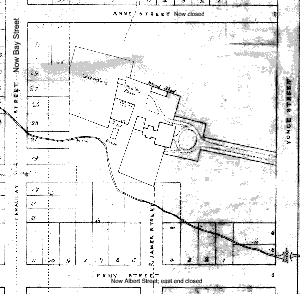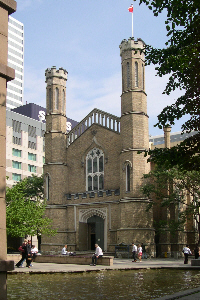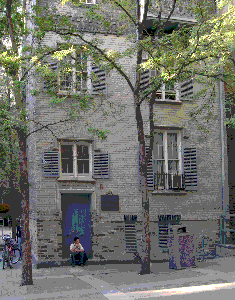
The Church of the Holy Trinity and Henry Scadding’s House now stand where James Macaulay built his home, Teraulay Cottage.

Macaulay property in 1845
Macaulay probably made the name up up from the Gaelic ter, (meaning land) and the root of Macaulay. As Surgeon to the British Forces, he was granted Park Lot 9 in 1797, one hundred acres west of Yonge Street, between Queen and Bloor Streets. Around 1818, the Macaulays exchanged land with their neighbours to the west, the Elmsleys, Giving both holdings Yonge Street frontage and making them more compact. The Elmsleys, took the parcels north of College Street, while the MacAuley’s chose the southern half.
James Macaulay, born in Scotland in 1759, was a surgeon with Simcoe’s regiment during the American Revolution. After that war, Simcoe asked Macaulay to join him at Niagara and later to go with him to York. Elizabeth Hayter, whom Macaulay married in 1790, was a childhood friend of Elizabeth Simcoe, and the two ladies regularly visited each other during their stays York. After Elizabeth died in 1809, he married Rachel Crookshank, sister of George Crookshank. For twelve years he was posted to Quebec City, where he was medical examiner and established military hospitals. He retired to York on half pay in 1817, where he served as senior medical officer until his death in 1822.
The eldest son, John Simcoe Macaulay, received the southern portion of the property fronting Lot Street (Queen St.) The second son, James Buchanan Macaulay, received a large parcel at the north edge of the estate, where he built Wickham Lodge. The Macaulays subdivided their land and it became York’s first working-class subdivision. Many of the streets in the area, James, Elizabeth, Hayter, Edward, Louisa, Teraulay, Jeremy, Anne, and Hagarman, bear family names. This area was annexed by the city in 1834 as St. Patrick’s Ward. Filled with working-class housing it had a population of 1,472. “The Ward”, as it came to be called, was an area of narrow alleys lined with sweatshops and dilapidated slum housing, the homes of many immigrants fleeing rebellions, famine, and persecution in Europe.
John Simcoe Macaulay disposed of the remaining Teraulay property to the Anglican Church and Teraulay Cottage was moved slightly north so that The Church of the Holy Trinity could be built on the site. Eventually, much of the decrepit housing was replaced with T Eaton Company factories. The Eaton Centre now occupies much of the Macaulays’ original country estate.
For more about the Macaulays and Teraulay Cottage, see “The Estates of Old Toronto” by Liz Lundell.
The Church of the Holy Trinity
The Church of the Holy Trinity opened in 1847. It was built using money originally given anonymously but later acknowledged by the doner, Mary Lambert Swale of Settle, England. Mrs. Swale had stipulated that all pews were to be free and unreserved, a principle of the High Church party in England at the time. The architect was H.B. Lane, who built several churchs including Little Trinity (on King Street) and St. George the Martyr.

During the depression years of the 1930s, this the church was known its work with the unemployed and homeless under the leadership of The Reverend John Frank, and his wife Patricia. They started the production of “The Christmas Story”in 1937, which has been produced every year since then. James Fisk, Rector from 1962-1976, encouraged the laity to take a much larger part in worship and governing the parish. The congregation, with supporters from the larger community, successfully fought efforts by a developer to have the church torn down. A fire in 1977 caused damage to the original ceiling and south windows. In 1989 the interior walls of the church and the organ were restored.
For more about The Church of the Holy Trinity go to its website.
Henry Scadding’s House

Located behind the Eaton Centre, adjacent to Holy Trinity Church, can be found 6 Trinity Square which was , the home of the Reverend Henry Scadding between 1862 and 1901. The historic plaque on the building reads: “Scadding was born in Devonshire, England in 1813, and came to Upper Canada in 1821. Educated at Upper Canada College and Cambridge University, he was ordained to the Anglican priesthood at St. James Church, Toronto, in 1838, and the same year became Master of Classics at Upper Canada College. In 1847 Scadding was appointed first rector of the nearby Church of the Holy Trinity, where he served until 1875. He lived in this town house, which complements the church and was designed by William Hay, from its completion in 1862 until his death. Here Scadding, a noted scholar, wrote numerous religious, literary, and historical works, including his best-known books, ‘Toronto of Old’(1873) and, in collaboration with J.C. Dent, ‘Toronto: Past and Present’ (1884).” For his father’s house see John Scadding House.
